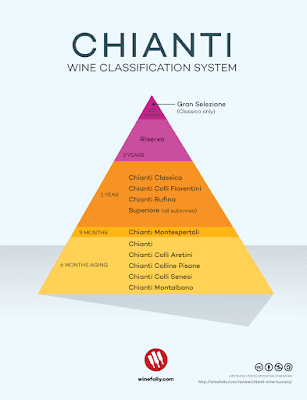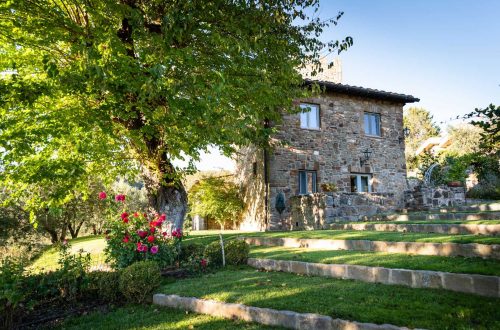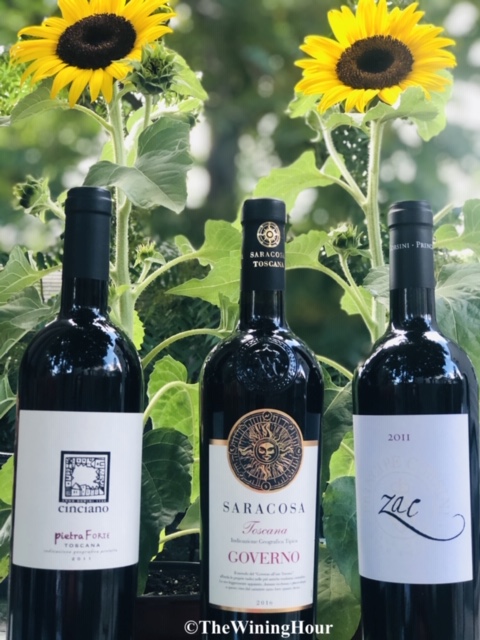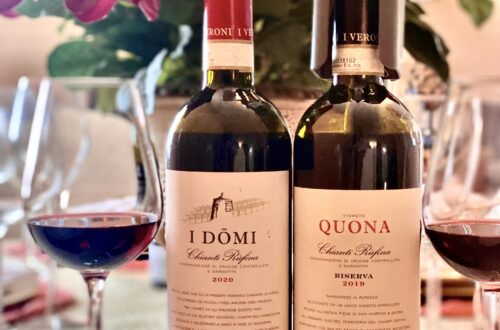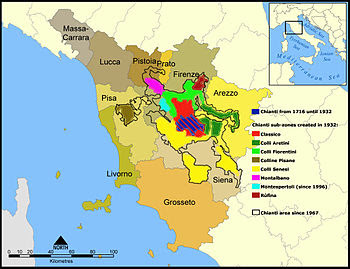 |
| Map of Chianti and the Sub-Zones |
Where in Chianti is Chianti Superiore produced?
Chianti Superiore wine is produced in eight sub-zones across the Tuscan provinces of Arezzo, Florence, Pisa, Pistoia, Prato and Siena. The sub-zones are: Colli Fiorentini, which stands for Florentine Hills, north of Florence; Montespertoli, which is southwest of Florence and within the Colli Fiorentini sub-zone; Chianti Rufina northeast of Florence; Classico, which is literally in the center of Chianti in the provinces of Florence and Siena; Colli Aretini in the province of Arezzo to the east; Colli Senesi south of Chianti Classico in the province of Siena, which happens to be the largest of the sub-zones and includes the Brunello di Montalcino and Vino Nobile di Montepulciano areas; Colline Pisane, in the province of Pisa to the west and Montalbano in the northwest part of the zone within the provinces of Prato, Pistoia and Firenze.
The Wining Hour Tasting of Chianti Superiore DOCG:
3 Chianti Superiore DOCG Wines
We did a pound for pound, bottle for bottle, wine for wine comparison, as it were, of three Chianti Superiore wines from different sub-zones. We tasted Fattoria Fibbiano Chianti Superiore (Colli Pisane), Banfi Chianti Superiore (Colli Senesi) and Ruffino Chianti Superiore (Colli Senesi). Here’s our findings:
Fattoria Fibbiano Casalini Chianti Superiore DOCG (Chianti Colli Pisane)
Colline Pisane is the sub-zone west of Florence in the province of Pisa. The region is a hilly area that is closer to the Mediterranean sea than most of the other sub-zones. This location contributes to a more moderate climate with warm sea breezes. Moreover, the Pisane area soil is in rich on fossil shells, composed of limestone-based clay and shale, as it was a seabed millions of years ago. The soil drains well and is very conducive to wine-growing. This was certainly manifested in Fattoria Fibbiano’s Chianti Superiore. I had the pleasure of visiting this winery in the summer and was able to see and taste the fruits of their labor and the Chianti Pisane terroir.
 |
Vineyards at Fattoria Fibbiano
Terricciola, Chianti Colli Pisane |
Casalini is produced from 80% Sangiovese and 20% Ciliegiolo grapes grown in mainly clay soil. After harvesting and fermentation, the wine is aged for 8 months in Slavonian oak barrels where malolactic fermentation occurs, and then bottled to age for at least another 3 months. Fattoria Fibbiano’s Casalini Chianti Superiore is ruby red in color with intense aromas of cherry, raspberry and blackberry. The palate is full of dark, ripe berries, vanilla and spice. The earthy, clay pot notes are evident as well. As some Chianti wines can be quite light-bodied, Fibbiano’s Chianti is more full-bodied, with a great layering of flavors, elegant tannins and a persistent finish. Casalini Chianti Superiore was enjoyed with a delicious rib-eye steak. Other red meats, pasta and ripe cheese would be good accompaniments.
Banfi Chianti Superiore DOCG (Chianti Colli Senesi)
Chianti Colli Senesi, in the province of Siena, is the largest of the sub-zones as it includes the southwestern part of Chianti Classico, far north to San Gimignano, and the areas of Montepulciano and Montalcino. As this zone is so large and diverse, the climate and soil also varies. Parts of the terroir reach to about 1000ft (300m) above sea level, providing abundant sunshine and cooling. Other parts are influenced by the Mediterranean sea. The soils tend to be sandy clay that drain well.
Castello Banfi is located in between the Orcia and Ombrone rivers in Montalcino. Their Chianti Superiore is made from 90% Sangiovese and 10% Cabernet Sauvignon and Canaiolo Nero grapes grown in Calcerous soil with a mixture of sand and clay. After maceration and fermentation, the wine is aged in French oak barriques. Banfi’s Chianti Superiore is an intense ruby red color, with fruit forward aromas and floral notes. Delicious violet, cherry, plum and red berries explode in the mouth. The oak contributes to the spicy fruit and tobacco flavors on the palate, along with vibrant acidity and structure.
This made a great match for my lasagna.
As per Banfi, their Chianti Superiore is “crafted to the meticulous profile of our estate, is pleasingly smooth and satisfying with its clean and distinctive flavors.”
Ruffino Ruffino Castello del Trebbio Chianti Superiore DOCG (Colli Senesi)
Athough another wine from the Chianti Colli Senesi sub-zone, Ruffino is very different. The location is different, the soil is different, the wine is different. First, Ruffino should not be confused with the Rufina sub-zone. Ruffino is a huge, well-known winery in Monteriggione, Siena. “Ruffino was among the first wineries to rediscover the Chianti Superiore appellation, which forms the perfect bridge between simpler Chianti DOCGs and more complex, deeper Chianti Classicos.” Ruffino’s Chianti Superiore is made from 70% Sangiovese blended with 30% Merlot and Cabernet Sauvignon grown in moderate clay and galestro rock soil. Following fermentation, this wine is aged in concrete and stainless steel vats and then the bottle. Ruffino Chianti Superiore is ruby in color, with more violet hues. It has fruity aromas with blackberries, plum, cherries and blueberries on the palate. This Superiore is light to medium-bodied and well-structured. This wine would also go with lasagna, other pasta dishes and antipasto.

Why Chianti Superiore or Chianti at all?
We tasted three very different bottles of Chianti Superiore. One was more rich and earthy, one more fruit forward and the other, aged in stainless steel, is more of a medium-bodied wine with darker fruit. It is clear that not all Chiantis taste the same. Regardless of whether they are from the same sub-zone or from wineries adjacent to one another, each Chianti comes with its own character. There are so many factors that impact wine production, including producer preferences and specialties, aging, cultivation and fermentation methods, amount of sun, level of elevation, and of course, the soil. Different terroir results in different tastes. In fact, we know that every vintage does not even taste the same! I have been to many wineries throughout Chianti and its sub-zones. They all have something different to offer. Each winemaker is able to reveal a different face, or should we say a different taste? Some Chiantis are more fruit forward, others more herbaceous, and others are chock-full of minerals and earth. The versatile characteristics of Chianti across the region and sub-zones can be likened to family members who all bear a resemblance to each other, yet each one has their own distinctive characteristics. Chianti is truly a wine with many faces. many personalities, many tastes. One can be pleasantly surprised by the diverse characteristics embodied by this region. This makes Chianti a prime region to spend more time and explore. After all, tasting one Chianti is NOT tasting them all!
What has been your experience with Chianti? Read on for more.
Join our Italian Food Wine and Travel group on Saturday Oct. 7 at 10am CDT on Twitter as we discuss our Chianti findings. We’ll all be posting and chatting, join us! Just look for the #ItalianFWT hashtag on Twitter Saturday morning! See what our Italian Food Wine & Travel Enthusiasts have to offer:
- Jennifer at Vino Travels Italy shares “Chianti of Terricola with Fattoria Fibbiano”
- Nicole at Somms Table shares “Cooking to the Wine: Borgo Scopeto Chianti Classico with Italian Meatloaf & Pasta Pomodoro”
- Jane at Always Ravenous shares “Classic Tuscan Ragù Paired with Chianti”
- Li at The Wining Hour shares “Chianti, A Wine with Many Faces”
- Jill at L’Occasion shares “Chianti Lessons”
- Jeff at Food Wine Click! shares “Rolling the Dice on a 1979 Chianti Rufina”
- Lynn at Savor the Harvest shares “Experience Chianti Classico with Montefioralle”
- Katarina from Grapevine Adventures shares “Collaboration, Passion, and Tradition Makes You Stronger – Vignaioli di Radda”
- Camilla at Culinary Adventures with Camilla shares “A Glass of Chianti & Dreams of Porchetta”
- Gwen at Wine Predator shares “Chianti: Beyond the Straw Bottle“
- Susannah at Avvinare shares “Wines from Chianti Colli Fiorentini – Worthy of Our Attention”
About The Wining Hour
The Wining Hour writes about wine, Italy and global travel. The Wining Hour boutique caters to wine-lovers across the globe by offering all wine-related items. The Wining Hour markets unique wine décor and furnishings, accessories, glassware, barware, wine racks, storage and cooling options, games, gifts and more. The Wining Hour also hosts #WiningHourChat on Twitter (@wininghourchat) on Tuesday’s at 9 p.m. EST.(For more, see links at the top of this page)
Get Social with The Wining Hour:



